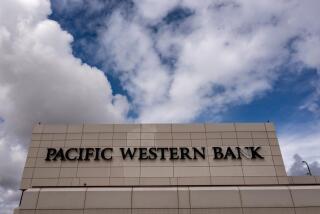The Big Banks Get Even Bigger
Is the neighborhood bank gone for good?
That’s the question raised by Monday’s dual announcements of multibillion-dollar bank mergers. The answer is no, but there’s also no question that mid-size regional banks in the U.S. are being gobbled up or are merging at a record pace.
Both the proposed $62.5-billion merger of BankAmerica and NationsBank and the planned $29-billion combination of First Chicago and Banc One rest on the axiom that bigger is better: That the key to survival in today’s heavily competitive, global marketplace for financial services is to be big enough to offer customers all they might need in one place. This is also the rationale behind last week’s announcement of plans for a mega-merger between Citicorp and Travelers Group, an insurance and brokerage company.
Proponents of these deals argue that to compete in global markets, the U.S. must remove legal barriers limiting bigger banks and move toward a European model of banking, in which a handful of titanic institutions dominate.
“The U.S. is going to start to look more and more like Germany or Britain, with universal banks,” said John Coffee, mergers and acquisition law professor at Columbia University. “Go back 50 or 60 years ago to when the supermarkets replaced the mom-and-pop stores. Banking here is just finally catching up.”
In the Netherlands, for example, the top three banks command more than 70% of all domestic business. Canadian banking is similarly dominated by five large banks, and Germany’s big three--Dresdner, Commerzbank, and Deutsche Bank--are held up as world-class exemplars of financial muscle.
This model enthralls executives of big American banks eager to grow even bigger. Banc One Chairman John B. McCoy, for example, argued at Monday’s news conference announcing his merger: “Canada has five banks. London has six banks. It doesn’t make sense for us to have 8,000 banks.”
But other experts say McCoy is overstating the case for large banks. “It may be true that 8,000 is too many, but 100 is too few,” says Greg Udell, a professor of finance at the Stern School of Business at New York University.
Udell noted that 188 new banks were federally chartered in the U.S. last year--the highest number since 1989--a sign that there is still plenty of room in the economy for institutions small enough to focus on relationship lending rather than large, generic transactions.
Major mergers like those announced on Monday, in fact, provide opportunities for the smaller banks, who scoop up anxious and angry customers.
“Every time you’ve got a big bank merger, you lose customers to the small banks,” said Bert Ely, a bank consultant in Alexandria, Va.
Some banking experts also contend that the virtues of big-bank domination and one-stop financial shopping in Europe and elsewhere have been widely misunderstood and vastly overstated.
“It’s true there are several European practitioners that put banking and investment banking and insurance under one roof,” said Richard J. Herring, professor of finance at the Wharton School of the University of Pennsylvania. “But the results have been less than spectacular.”
Others stress that the financial systems of countries like Germany are so different from the United States that holding Europe up as a model is perilous.
Germany’s reputation for being dominated by three mammoth banks derives from the huge economic power of those institutions. But together those three account for only 25% of the domestic banking market, with the balance served by thousands of small local cooperatives that resemble American savings and loans or credit unions.
The finance market of Germany, like other European countries, is also much more heavily bank-oriented than in America, where mutual fund companies, independent brokerages and huge debt and equity markets compete with banks to provide capital to corporate and individual customers.
Europe’s market is also different in its needs. For example, Europe is impressed with the concept of creating “national bank champions,” so that each country can have at least one large bank to block out foreign competition and serve as a loud voice in any European Commission debate on banking matters.
Perhaps the most controversial rationale for the wave of U.S. bank mergers is that big banks can capture economies of scale they can pass on to customers. Academic experts say that’s a myth.
“If you dissect the idea of large economies of scale, they’re not evident in banking,” says Ingo Walter, Charles Simon professor of applied financial economics at New York University.
Walter argues that in almost every case to date, the economies captured in the course of giant bank mergers have come from eliminating existing inefficiencies by laying off thousands of employees.
These gains, although often substantial, occur only once, and often leave the merged institutions struggling to complete difficult mergers of disparate cultures and businesses.
As for the synergies apparent in offering, say, life insurance, home mortgages and stock-market brokerage services to the same customers--the “financial supermarket” pitch--Walter argues that the commonalities among those services are less than claimed, and the complexities of managing them together are greater.
Still, despite such difficulties, most analysts agreed Monday that the number of banking mergers will only increase this year with the U.S. industry still so highly fragmented. Indeed, even after the BankAmerica-NationsBank merger, the new company would control only about 8% of bank deposits in the U.S.
“While this is a huge company, they only have a small piece of the market,” said Thomas Theurkauf, analyst with Keefe Bruyette & Woods. “Believe it or not, the banking industry in America remains very fragmented. I think we’re in for a torrent of activity.”
(BEGIN TEXT OF INFOBOX / INFOGRAPHIC)
Branching Out
In a deal that would create the nation’s second-largest banking company, San Francisco-based BankAmerica and NationsBank agreed to merge in a $62.5-billion stock swap. The combined company would hold about 8.2% of U.S. deposits.
At a glance
*--*
BankAmerica NationsBank Deposits $172.0 billion $138.2 billion Assets $260.2 billion $264.6 billion Loans $167.1 billion $143.8 billion Monday stock $91.13, $80.63, price/change +$4.63 +$4.19 Market capitalization $62.5 billion $76.0 billion
*--*
Note: Deposits, assets and loan figures are as of Dec. 31.
Biggest banking companies in U.S.
*--*
Assets Rank Bank Location (billions) 1 Citicorp/Travelers Group Inc.* New York $697.5 2 NationsBank/BankAmerica Corp.* Charlotte, N.C. 568.0** 3 Chase Manhattan Corp. New York 365.5 4 J.P. Morgan & Co. New York 262.2 5 Banc One Corp. /First Chicago NBD Corp.* Columbus, Ohio 239.5 6 First Union Corp.* Charlotte, N.C. 205.7 7 Bankers Trust New York Corp. New York 140.1 8 Wells Fargo & Co. San Francisco 97.5 9 Norwest Corp. Minneapolis 88.5 10 Fleet Financial Group Inc. Boston 85.5
*--*
Note: Assets as of Dec. 31.
*Pending
** Includes NationsBank and Bank of America assets.
FIVE largest U.S. bank and thrift deals
*--*
Date Deal value Rank Companies announced (billions) 1 Travelers Group Inc. /Citicorp* 4/6/98 $83.0 2 NationsBank Corp. /BankAmerica Corp.* 4/13/98 62.5 3 Banc One Corp. /First Chicago NBD Corp.* 4/13/98 29.0 4 First Union Corp. /CoreStates Financial Corp.* 11/18/97 17.1 5 NationsBank Corp. /Barnett Banks Inc. 8/29/97 15.5
*--*
* Pending
Note: Value figures are when the deal was announced.
Sources: Federal Deposit Insurance Corp., SNL Securities, company reports Researched
More to Read
Sign up for Essential California
The most important California stories and recommendations in your inbox every morning.
You may occasionally receive promotional content from the Los Angeles Times.











